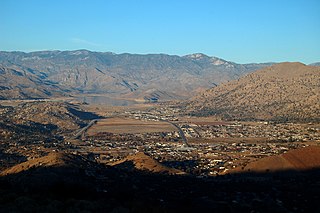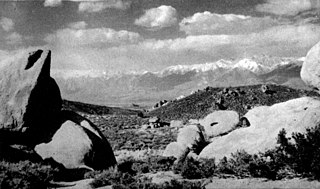Related Research Articles

Lake Isabella is a census-designated place (CDP) in the southern Sierra Nevada, in Kern County, California, United States. It is named after the Lake Isabella reservoir and located at its southwestern edge, 6 miles (9.7 km) south of Wofford Heights in the Kern River Valley.
Lassic was a Wailaki leader during the Bald Hills War.
Keyesville is an unincorporated community in Kern County, California. It is located 2 miles (3.2 km) west of Lake Isabella and the Kern River Valley, at an elevation of 2,848 feet (868 m). Keyesville, founded in 1854 is named for Richard M. Keyes, whose discovery of gold in 1853 started the Kern River Gold Rush. The Keyesville Townsite has been privately owned since the late 1800's and is currently encircled by BLM land Bureau of Land Management.

The Tübatulabal are an indigenous people of Kern River Valley in the Sierra Nevada range of California. They may have been the first people to make this area their permanent home. Today many of them are enrolled in the Tule River Indian Tribe. They are descendants of the people of the Uto-Aztecan language group, separating from Shoshone people about 3000 years ago.

Scovern Hot Springs is a thermal spring system, and former settlement in the Kern River Valley of the Southern Sierra Nevada, in Kern County, California.

The Tule River Indian Tribe of the Tule River Reservation is a federally recognized tribe of Native Americans. The Tule River Reservation is located in Tulare County, California. The reservation was made up of Yokuts, about 200 Yowlumne, Wukchumnis, and Western Mono and Tübatulabal. Tribal enrollment today is approximately 1,857 with 1,033 living on the Reservation.

The 2nd Regiment California Volunteer Cavalry was a cavalry regiment in the Union Army during the American Civil War. It spent its entire term of service in the western United States, with most of its companies dispersed to various posts.

The District of Southern California was a 19th-century district of Department of the Pacific, a command of the United States Army.
Visalia, California, commonly known in the 1850s as Four Creeks, is the oldest continuously inhabited inland European settlement between Stockton and Los Angeles. The city played an important role in the American colonization of the San Joaquin Valley as the county seat of Old Tulare County, an expansive region comprising most if not all of modern-day Fresno, Kings, and Kern counties.
George Spafford Evans was a military officer, miner, businessman, county clerk for Tuolumne County, customs official, and clerk for the California State Senate.
Daley's Ferry Post was located at Daley's Ferry crossing of the Mad River nearly three miles from the town of Arcata in Humboldt County. On June 6, 1862 the ferry had been attacked by Native Americans:
Headquarters Humboldt Military District,
Fort Humboldt, June 8, 1862.
Major: I have the honor to report that on the 6th instant, at 4 p. m., the house or hotel at Daley's Ferry, on Mad River, about five miles from Arcata, and on the most constantly traveled trail, was attacked by a band of Indians, some fifty or sixty in number, all well armed with rifles and shotguns. There were but two soldiers stationed there, as the owner deemed it hardly necessary to have any guard so near to town, and on a public highway. The Indians opened the attack by a volley from the brush. Private Bacon was wounded in the groin at the first fire, but he and his comrade, Private Wyatt, rushed to the house and commenced firing from the windows. Daley also ran to the house, but leaving his family behind, he seized his rifle and fled to his boat in the river. Our soldiers, thus left alone, directed the women and children to endeavor to reach the boat, and they would remain and keep the Indians at bay. The family were successful in making good their escape to the boat, when our men, keeping up their fire, retired slowly, both being now wounded and faint from the loss of blood. Wyatt only was able to reach the boat. Bacon concealed himself behind a log in the brush, and from that position saw and counted twenty-seven Indians who entered the house, pillaged and set it on fire. The party in the boat were immediately fired upon by about twenty Indians on the opposite bank. An old lady, mother of Mrs. Daley, was struck by three balls and killed. Mrs. Daley was wounded in the arm, and Private Wyatt was again wounded, and in the arm under the shoulder, the ball grazing his breast, he being in the act of firing. His first wound was in the groin, and similar to that of Bacon. They were then forced to put back to the shore, escaping into the brush. Mrs. Daley struggling along with two children at last fell from exhaustion, upon which her husband cowardly abandoned her, throwing his infant that was in his arms into the bushes and making for Arcata. Some Indians came up to Mrs. Daley, robbed her of her rings and purse, and said they would not "kill white squaw. " The brave woman made another effort and walked some distance; then taking off off some of her clothing wrapped it around the two eldest, hid them in the bushes and kept on, carrying her infant in her arms, one of which was torn open from the elbow to the wrist by a rifle bullet. She was rescued at last by people from Arcata who came out for the purpose, and who by her directions found the children calmly sleeping at about 2 a. m. Our wounded men were also found, and are now in the hospital at this post, their wounds, though severe, not proving dangerous. I hired man is missing and supposed to be killed, and the Indians carried off a nephew of Mrs. Daley, about five years old. I beg leave most respectfully to bring to the notice of the general commanding Private Joseph N. Bacon, Company I, and Private Henry H. Wyatt, Company H, Second Infantry California Volunteers, for admirable coolness and bravery under the most trying circumstances. I omitted to mention that the soldiers finding themselves disabled put their arms out of the reach of the Indians, one hiding his musket in the brush the other throwing his piece into the stream.
I have the honor to be, most respectfully, your obedient servant,
Jas. N. Olney,
Lieutenant Colonel Second Infty. Colonel Vols., Commanding Humboldt Mil. Dist.
Major R. C. Drum, U. S. Army,
Assistant Adjutant-General, San Francisco.:

The Kern River Valley is a valley and region of the Southern Sierra Nevada, in Kern County, California.

The Owens Valley War was fought between 1862 and 1863 by the United States Army and American settlers against the Mono people and their Shoshone and Kawaiisu allies in the Owens Valley of California and the southwestern Nevada border region. The removal of a large number of the Owens River indigenous Californians to Fort Tejon in 1863 was considered the end of the war. Minor hostilities continued intermittently until 1867.
The Stockton–Los Angeles Road, also known as the Millerton Road, Stockton–Mariposa Road, Stockton–Fort Miller Road or the Stockton–Visalia Road, was established about 1853 following the discovery of gold on the Kern River in Old Tulare County. This route between Stockton and Los Angeles followed by the Stockton–Los Angeles Road is described in "Itinerary XXI. From Fort Yuma to Benicia, California", in The Prairie Traveler: A Hand-book for Overland Expeditions by Randolph Barnes Marcy. The Itinerary was derived from the report of Lieutenant R. S. Williamson on his topographical survey party in 1853, that was in search of a railroad route through the interior of California.
Moses A. McLaughlin (1834–1899) was an Irish-born California Militia officer, Union Army officer, farmer, later a medical doctor. As Captain, 2nd Regiment California Volunteer Cavalry, he is best known for his role in the 1863 Keyesville Massacre, and subsequent campaign that forced the capitulation of the Owens Valley Paiute in the Owens Valley Indian War and their removal to Fort Tejon.
Joaquin Jim was an Eastern Mono, war leader of the Owens Valley Indian War. Joaquin Jim, implacable war leader of the Mono allies of the Owens Valley Paiute, never surrendered to American forces or made peace with them, but reported to have ceased warfare against them in 1864.
The California Indian Wars were a series of wars, battles, and massacres between the United States Army, and the Indigenous peoples of California. The wars lasted from 1850, immediately after Alta California, acquired during the Mexican–American War, became the state of California, to 1880 when the last minor military operation on the Colorado River ended the Calloway Affair of 1880.
The Tule River War of 1856 was a conflict where American settlers, and later, California State Militia, and a detachment of the U. S. Army from Fort Miller, fought a six-week war against the Yokuts in the southern San Joaquin Valley.

Camp Babbitt was an American Civil War Union Army camp located in two sites in the vicinity of Visalia, California.

California Water Service, commonly known as Cal Water, is an American company providing drinking water and wastewater services to a number of regions within the state of California. It was founded in 1926 and is based in San Jose, California, and provides service across multiple local districts, reaching more than 484,900 customers.
References
- 1 2 Price, Robert (April 15, 2023). "160 years ago, a culture-defining atrocity on the Kern River". The Bakersfield Californian. Retrieved April 17, 2023.
- ↑ Official Records of the War of the Rebellion Series I, vol. 50, Part 2, p. 386. Colonel R. C. DRUM, Asst. Adjt. General, Dept. of the Pacific to WM. JONES, Lieutenant-Colonel, Commanding Camp Babbitt.
- ↑ McLaughlin in his report mistakes the name Waldron, who was actually William B. Weldon, the partner of J. V. Roberts in a cattle ranching and butcher business supplying Keyesville with its beef. A populated place, Weldon, California, on the South Fork of the Kern River east of Lake Isabella is named after him. Wallace M. Morgan, History of Kern County, California, with biographical sketches of the leading men and women of the county who have been identified with its growth and development from the early days to the present, Historic Record Company, Los Angeles, California, 1914. p.37, 44
- ↑ "The war of the rebellion: a compilation of the official records of the Union and Confederate armies," SERIES I VOLUME L., IN TWO PARTS. PART I REPORTS, CORRESPONDENCE, ETC.; Government Printing Office, Washington D.C., 1897. pp. 208-210
- ↑ Mayer, Steven (April 19, 2007). "April 19: A day of solemn remembrance". The Bakersfield Californian. Retrieved September 22, 2015.